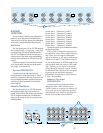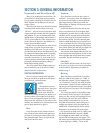
13
PHONES
The PHONES 1 (16) and PHONES 2 (17) sec-
tions are identical. Each
contains a stereo level control
for the headphones outputs, a
stereo SOLO switch, and five
pushbuttons to select from the
following signal sources: MONITOR, MIX-B, AUX
SENDS 3 & 4, AUX SENDS 5 & 6, and EXTERNAL.
You can select any combination of sources.
• The MIX-B, AUX SENDS 3 & 4 and AUX SENDS
5 & 6 switches are connected directly from the
outputs of their respective circuits.
• MONITOR takes the signal from after the
MONITOR selection switches described below,
and therefore carries the same signal that is
applied to the control room monitors. (The
PHONES section is not affected by the CNTL RM
level control or the MONO switch in the MONI-
TOR section, though.)
• The EXTERNAL switch is connected directly
from the L and R EXTERNAL INPUTS in the jack
panel above. External is an independent cue
channel for click tracks, etc. Its signal DOES NOT
appear at any of the channels or buses.
NOTE: If MONITOR is selected as a PHONES
source and the solo button in the PHONES section is
depressed, nothing will happen except that the Solo
LEDs will light up. That’s because Solo is disabled
under these conditions to prevent a feedback loop
and its associated anguish.
NOTE: if nothing is selected, signal may still feed
the PHONES from AUX Return 3 & 4, via that
section’s ASSIGN TO PHONES switches.
MONITOR
The control room monitors and the studio play-
back monitors are both controlled from the
MONITOR section of the console (18). There is a
stereo level control for the control room and an-
other for the studio. NOTE: Fully clockwise
equals unity gain.
A bank of switches selects
the stereo sources available to
the speakers from L/R Mix,
MIX-B, Tape and External.
You can select any combina-
tion of signal sources.
The L/R MIX and MIX-B switches are con-
nected from the outputs of the L/R and MIX-B
buses. The TAPE and EXTERNAL switches are
connected from the 2-TRACK INPUTS and the
EXTERNAL INPUTS, respectively, on the jack
panel above.
The MONO switch sums the left and right
channels together to allow you to check your mix
in monaural. This affects only the control room
monitor speakers, the studio monitor speakers,
and the L/R meters (although the meters are not
monoed in solo mode.)
SOLO
The Solo section (19) contains the master
level control for the stereo Solo mix. Set at the
center detent, it will match the level of the soloed
signals to the same signals unsoloed. This section
also has the most obnoxious solo light allowed un-
der international trade and safety regulations. We
hope it gets your attention. The monitor switch in
the phones section must be pushed in (selected)
or the solo bus will not feed the phones. (By the
way, if your console has two little tiny Death’s Heads
above your RUDE SOLO LITE, you are very lucky.
Only one in 10,000 Mackie consoles has what we call
“Grim Greg” on it, and if you send in the top panel of
your console with proof of purchase, we will ship
postpaid to your door the bivalve pride of the North-
west, a Quilcene-smoked Geoduck filet, with our
compliments!)
TALKBACK
The talkback section has four momentary
pushbutton switches, which assign talkback to
any combination of AUX Send 1, AUX Send 2,
TAPE SUBGRPS (L/R MIX and the 8 SUBMAS-
TERS) and PHONES/STUDIO. Try setting the
talkback level at the center detent for starters. It
can be tweaked up or down to your liking.
Note: When talkback is engaged, only the con-
trol room outputs are padded by 20dB to avoid
feedback, yet still allow the engineer to hear the
musicians. The studio output is not padded. In
situations where either the control room level is
set way up, or there is a speaker pointing at the
console, there may still be feedback. To prevent
this, turn down the talkback level, the control
room level, or change the angle of the control
room speakers.
The Talkback Microphone is located just above
the L/R MIX fader. This ain’t no Neumann, so
don’t attempt vocals through it (we wanted it to
sound gritty and generally talkback-esque). Appli-
cation of chewing gum to this orifice will degrade
performance further to simulate really beat-up
AM radio production studios.
LAYOUT
AND
FUNCTION


















